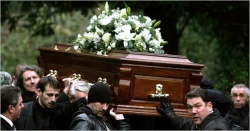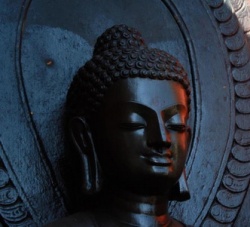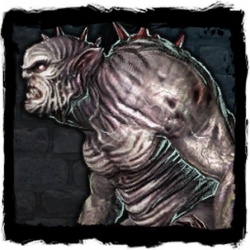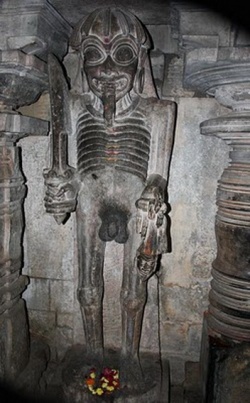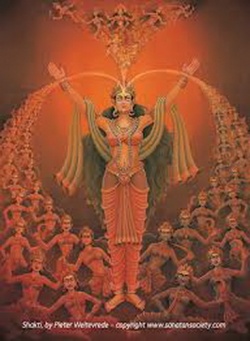Dying After Death: The Buddha's Final Liberation
The Joy of Death
Once when The Buddha was wandering in search of alms with his Disciple Ananda, a devotee offered them two golden drapes. Ananda was astonished to observe that when the Lord wore the robe, it seemed to loose its luster, paling in comparison to The Buddha’s own Body. The ancient texts present this picture in a verse:
Two robes were they offered of gold,
Brighter shone the teacher manifold. (Digha Nikaya: 16.4.38)
The Buddha explained to his Disciple that there are two occasions when his skin turns exceptionally bright. One was the night when he gained supreme Enlightenment (Nirvana) and the other when he would finally pass away without any remainder (Complete or Pari-Nirvana).
This was not the only instance when the Venerable Buddha equated Enlightenment with final demise. When eating a meal at the house of one his devotees named Chunda, he became seriously ill and it was clear that the end was near. Lest after him his followers chastise Chunda, The Buddha said:
"It is to your Merit Chunda, that I am going to final Nirvana after taking this last meal from you. Two offerings of Food are more meritorious than any other. The first is the one after eating which I attain supreme Enlightenment, and the other after which I gain the Nirvana without remainder." (D.N. 16.4.42)
In fact, The Buddha looked forward to the day when his Body would fall and he be finally released from the bondage of Life and Death. During his last moments he asked his followers not to grieve and said:
"Don’t mourn at this moment of Joy." (BC 25.68)
"Is it proper to lament and weep for me when this Body, the great storehouse of Suffering is passing away? The great danger of Rebirth is at last being uprooted, and I am being released." (Buddhacharita 25.71)
"When the darkness of Ignorance within me has been illuminated with the lamp of Knowledge, and I have seen the World to be without essence, then Contentment accompanies my end as does the cure to an illness." (BC 26.86)
"Peace is gained only from that peace which leaves no residue behind." (BC 27.2)
Buddha’s Life – The Key to His Death
To understand Buddha’s approach to Death we have to go back to his Life. When he was exposed to the three inevitable sufferings, which must be undergone by all living beings – namely disease, old age and Death the would-be-Buddha was taken aback with fear.
The charming and ancient poem Buddhacharita, forming one of the principal sources for the Life of Buddha, describes his poignant encounter with Death:
"This person bereft of intelligence, sense organs and Breath, is now but a lifeless log of wood. He is abandoned by his near and dear ones who had once painfully taken care of him. Destruction indeed is inevitable for all in the World" (BC 3.57)
Till then having led a sheltered existence of consumption and enjoyment, the shock of his eventual Destiny shook him to the core. Buddha realized that Death is the only certainty in this uncertain World. How then could one pass his hours in indulgence when the sword of time ‘kala’ hung threateningly over his head? The true Destiny of humanity was to reach that fearless state (Abhaya Pada) which transcended Death.
He lamented:
"Which rational being could be at ease, or still less laugh, when he knows of old age, disease and Death? Which sentient being could remain unmoved on seeing an aged, ill or dead person? This is perhaps like a tree which remains unaffected even as its neighbor falls bereft of Flowers and fruit or is cut down mercilessly." (BC 4.59-61).
It was only later when he witnessed a wandering Monk with an unmistakable calm on his face did Gautama felt that salvation was possible. The Monk who had withdrawn himself from the World had in a sense died to it. Indeed, the only way to defeat Death was to die before Death. Since Death is but an impetus to a fresh birth (and Death), when overcome in this manner, there is no coming back to this World.
The Nature of ‘Virtual Death’
Regarding the nature of withdrawal from this external World, The Buddha gives a vivid example of a time when he was staying at a small town and saw a crowd gathered near his dwelling. He asked a person standing nearby:
"Friend, why are all these people assembled here?"
"Sir, there has been a great storm which has killed two farmers and four oxen. But you my Lord, where have you been?"
"I have been right here, friend."
"What did you see my Lord?"
"Dear friend, I saw nothing."
"What did you hear?"
"I heard nothing."
"Were you sleeping dear sir?"
"No friend I was not asleep."
"Then sir, were you conscious?"
"Yes, I was conscious."
Even though fully awake, The Buddha neither saw nor heard the great storm raging outside, so absorbed was he within his own self. This is parallel to the ancient Indian ideal of ‘atmaram’, or the contented soul ‘which sports within its own self.’
No wonder then that this ideal formed an important constituent in Buddha’s final discourse:
"I am now worn out, having completed eighty years. As an old cart can be held together only with the help of straps so have I kept my Body going. It is only when I withdraw my attention from all outward things and concentrate it inwards that I know comfort. Thus you too become a lamp (deepa) unto yourselves, illuminating your inner selves, relying on no external help, becoming your own Refuge." (DN 16.2.26)
Interestingly, the Pali word ‘deepa’ rendered above as lamp also can mean ‘dvipa’ or island, which is indeed preferred by many translators. In that case the words of Buddha hold a beautiful meaning suggesting each of us to live like islands, detached from the World, where however, some near and dear ones may alight for a short while and then disperse, without us being attached to them in any manner. The Buddha says:
"Like birds spending a night together on a tree, and going their separate directions the next morning, so inevitably the union of all beings ends in parting."
"As clouds coming together in the sky only to separate again, so do creatures collect together and then disperse." (BC 6.46-47)
The Path to Virtual Death
Ancient Indian tradition recognizes two ways of living in this World:
1). Pravrtti Dharma (Inclination to action)
2). Nivrtti Dharma (Finished with action)
The Buddha makes his preference clear:
"Set your Mind on the cessation of activity (nivrtti), because where there is no inclination to action (pravrtti), there is no Suffering" (BC 20.43)
"The continuance of active being (pravrtti) is Suffering and the cessation thereof (nivrtti) is freedom from Suffering." (BC 26.18)
He put it eloquently in a verse:
"Monks do collect your thoughts,
Be mindful restrain all resolves." (DN 16.3.51)
Considering the fact that with his Parinirvana Buddha attained final and total freedom from all Karma (pari-nivrrta), his visible Joy at his impeding end is but understandable.
However, for ordinary folks like us, less traveled on the path of Enlightenment, the Thought of bereavement from The Buddha could be highly traumatic as it was for many of his disciples. The ever-compassionate Buddha tried his best to calm them with the words:
"Recognize the true nature of this World and don’t be anxious, for separation is but inevitable. Strive that this World never happens to you again (i.e. you are not born again)" (BC 26.85)
What After The Buddha?
To the grieving Monks assembled at his final gathering, anxious as to how they would bear their separation from him, The Buddha said:
"Whether my Body remains or I pass away – it will be the same, because even then my Dharmakaya (THE DHARMA preached by me) will remain in this World. It does not then matter that my Form remains or not." (BC 24.20)
"Salvation does not come from the mere sight of me without strenuous yogic practices. Whoever thoroughly understands my law, is released from the net of Suffering even though he may never see me." (BC 25.77)
"Just as man cannot be cured of a disease by the mere sight of a physician without taking the prescribed medicine, similarly the one who hears my Dharma but does not put it into practice, he cannot be liberated by mere sight." (BC 25.78)
Then he said what can act as a comforting reassurance to those of us Feeling lost in the vast ocean of the modern World:
"In this World, a self-controlled practitioner of Dharma, even though he may be far from me, is seeing me, while he who does not conform to the highest good may dwell at my side and yet be distant from me." (BC 25.79)
Conclusion: The Compassion of Buddha
After his supreme Enlightenment, there remained only one thing binding The Buddha to this World – his Body. However, out of Compassion for his fellow beings, Buddha continued to survive physically even after Nirvana. It was only when he realized that his work was done, and a solid foundation laid for THE DHARMA did he finally decide to let his Body fall, putting his feelings into the following verse:
I wandered forth when twenty-nine,
To seek well-being, the Life divine,
Since then fifty have gone over this Life of mine. (DN 16.5.27)
Ripened is my Life,
Little remains to thrive,
All’s done I need not survive. (DN 16.3.51)
References and Further Reading:
Carus, Paul. The Gospel of Buddha (According to Old Records) Chennai, 2002.
Johnston, E.H. Asvaghosa's Buddhacarita or Acts of The Buddha (Complete Sanskrit Text with English Translation) Delhi, 2004.
Schotsman, Irma. Asvaghosa's Buddhacarita The LIFE OF THE BUDDHA (Sanskrit Text with Word-by-Word Translation, Melodies for Chanting and Verses in English Grammatical Explanation) Sarnath, 1995.
Seth, Dr. (Mrs.) Ved. Study of the Biographies of The Buddha: New Delhi, 1992.
Shastri, Swami Dwarikadas. Buddhacharitam (Pali Text with Hindi Translation in Two Volumes): Varanasi, 2004.
Shastri, Swami Dwarikadas (ed.). Dighanikayapali (Pali Text with Hindi Translation in Three Volumes): Varanasi, 2005.
Sivananda, Swami. Yoga Vedanta Dictionary Uttaranchal, 2004.
Walshe, Maurice. The Long Discourses of The Buddha (A Translation of the Digha Nikaya): Boston, 1995.
